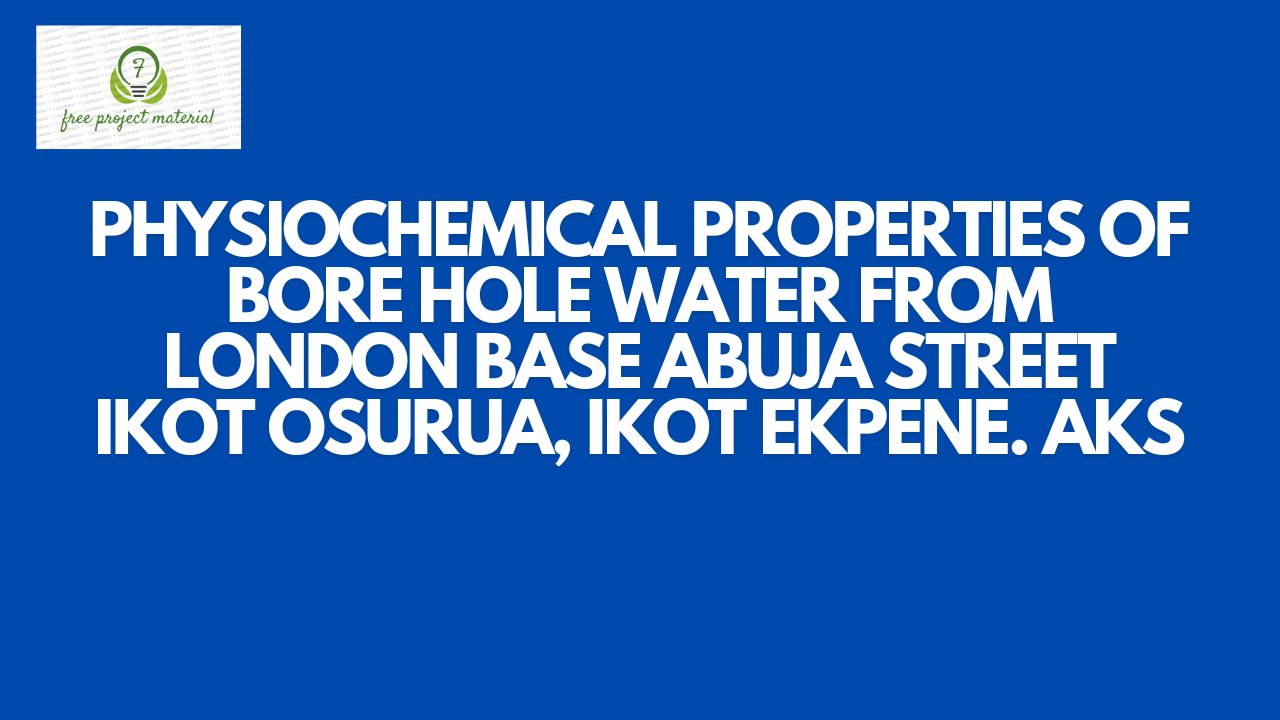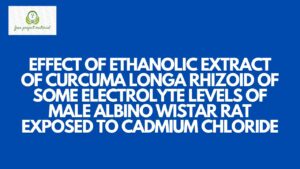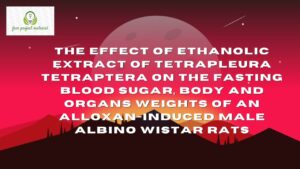ABSTRACTS
Physiochemical parameters of water from London base bore hole were analyzed using standard chemical analytical procedures. The parameters tested for were odour, colour, taste, temperature, conductivity, TSS, total dissolving substances (TDS), Dissolved oxygen (DO), Biological Dissolved oxygen (BDO), Acidity, Alkalinity, sulphate and nitrate. The result revealed that the water sample were colourless, odourless and tasteless. The water sample had the temperature of 29.0. the conductivity test showed that the water sample has the value of 11.90NSCM followed by TSS 0.02, TDS 1.25g, DO 2.81, SO42- 2.0, NO32- 0.001 and the value obtained agree with WHO and EPA standard as the permissible guideline/limit for drinking water.
LIST OF TABLES
Table 4.1: The result of the physiochemical parameters of water obtained from London based bore hole – – – – – – -32
TABLE OF CONTENTS
PAGES
TITLE PAGE – – – – – – – – i
CERTIFICATION – – – – – – – ii
DEDICATION – – – – – – – – iii
ACKNOWLEDGMENTS – – – – – – iv
ABSTRACTS – – – – – – – – v
LIST OF TABLES – – – – – – – vi
TABLE OF CONTENTS – – – – – – vii-ix
CHAPTER ONE
INTRODUCTION
1.1 Background of the Study – – – – – 1-4
1.2 Aims and Objectives of the Study – – – – 4
1.3 Scope and Limitations of the Study – – – – 5
1.4 Definition of Terms – – – – – – 5-6
CHAPTER TWO
LITERATURE REVIEW
2.1 Properties of Water – – – – – – 7
2.1.1 Physical Properties of Water – – – – – 7-8
2.1.2 Chemical Properties of Water – – – – – 8-9
2.2 Forms of Water – – – – – – – 9
2.2.1 Liquid Water – – – – – – – 10
2.2.2 Water Ice – – – – – – – – 10-11
2.3 Uses of Water – – – – – – – 11-12
2.4 Uses of Water – – – – – – – 12
2.4.1 For Drinking – – – – – – – 12-13
2.4.2 For Washing – – – – – – – 13
2.4.3 For Chemical Uses – – – – – – 14
2.4.4 Fire Extinction – – – – – – – 14
2.5 Water Pollution – – – – – – – 15
2.6 Causes of Water Pollution – – – – – 16-18
2.7 Effect of Water Pollution On Human – – – – 18-19
2.8 Water Pollution Categories – – – – – 19
2.8.1 Point Source – – – – – – – 19-20
2.9 Anthropogenic Activities in Water Pollution – – 20
2.9.1 Domestic Sewage – – – – – – – 20
2.9.2 Agricultural Water and Runoff – – – – – 21
2.9.3 Acid Rain – – – – – – – – 21-22
2.9.4 Global Warming – – – – – – – 22
2.10 Control and Management of Water Pollution – – 22-24
CHAPTER THREE
MATERIALS AND METHOD
3.1 Materials – – – – – – – – 25
3.2 Sampling Method – – – – – – – 26
3.3 Sample Collection – – – – – – – 26
3.4 Determination of Physiochemical Parameters
of Water Sample – – – – – – – 27
3.4.1 Determination of Temperature – – – – – 27
3.4.2 Determination of Conductivity – – – – 27
3.4.3 Determination of pH – – – – – – 28
3.4.4 Determination of Total Dissolving Substance – – 28
3.4.5 Determination of Acidity (PA) – – – – – 29
3.4.6 Determination of Alkalinity – – – – – 29
3.4.7 Determination of SO-2 – – – – – 30
3.4.8 Determination of NO3 – – – – – – 30
3.4.9 Determination of Biochemical Demand (BOD) – – 30-31
CHAPTER FOUR
RESULT AND DISCUSSION
4.1 Result – – – – – – – – 32
4.2 Discussion – – – – – – – – 33-35
CHAPTER FIVE
SUMMARY, RECOMMENDATION AND CONCLUSION
5.1 Summary – – – – – – – – 36
5.2 Recommendation – – – – – – – 37
5.3 Conclusion – – – – – – – – 37
References
CHAPTER ONE
INTRODUCTION
1.1 Background of the Study
Water is one of the most abundant essential resources of man, and occupies about 70% of earth’s surface. About 97% of this volume of earth’s surface water is contained in the oceans, 21% in polar ice and glaciers, 0.3-0.8% underground 0.009% in inland freshwater such as lake, while 0.00009% is contained in river (Kulshrehtha, 2008).
Water in its pure state is acclaimed key to health and the general contention is that water is more basic than all other essential things to life. So drinking water is essential to human and other life forms even though it provides no calories or organic nutrient. Access to safe drinking water has improved over the last few decades in almost every part of the world, but approximately one billion people still lack access to safe water and over 2.5 billion lack accesses to adequate sanitation (Arnold, 2010). Water is the most important natural resources in the world. As it function as a solvent for a wide variety of chemical substance and facilities industrial cooling temperature and agriculture (Baroni et al., 2007).
Portable water is the fundamental need of man to sustain life. Water serves as lubricant, regulate the body temperature and provide the basic for the body fluid and metabolism (Stact, 2005). Drinking water should be suitable not only for human consumption but also for washing, showering and domestic food preparation because chemicals and other constituent of the water would give rise to economical damage as well (Tihansky, 1974). Water is a good solvent and picks up impurities easily and thus change it taste, colour and odour.
It is well-knowned fact that, when water is polluted, its normal functioning and properties are effected (Trivedi et al., 2010). Continual improvement in the quality of water for purpose of drinking, domestic consumption, person hygiene and certain medical situation is among the top challenges of the whole. A silent humanitarian crists is the killing of about 3900 children everyday and progress toward all the Millennium Development Goals (MDGs), especially in Africa and Asia (Bartram et al., 2005). Worldwide waterborne diseases are the causes of death and suffering of millions of people, especially, children in the developing countries (Schafera et al., 2009). The provision of high quality drinking water is one of the most important connote for improving human health of a community by preventing the spread of water torn diseases (Benjamin and Brown, 2003). Drinking water plays an important role in the transportation of essential minerals and reduces the elevated levels of non-essential element which can cause morphological abnormalities, reduce growth, increases mortality and mutagenic effects (Nkono and Asubiojo, 1998; Asaolu, 2002; Adeyeye, 2000).
Contaminants are substances that are dissolved in water and make it unfit for use. Some contaminants can be easily identified only by assessing the taste, odour and turbidity of the water because pure water remain tasteless, colourless and odourless. However, most cannot be easily detected and required testing to reveal whether or not water is contaminated. Physio-chemical parameters of water are important to determine the quality of drinking water as according to WHO (2000). The physical parameters that are likely to give rise to complaint from consumers are colour, taste, odour and turbidity while low pH cause corrosion and high pH result in taste complaints (Chan et al., 2007). I t is therefore vital to assessed the pysio-chemical properties of our bore hole water to ascertain its suitability for domestic used.
1.2 Aim and Objectives of the Study
The aim of this study is to assess the physical and chemical properties of bore hole water sample at London base Abuja street Ikot Osurua under the following objectives;
- To determine the chemical properties of bore hole water.
- To compare the physical properties of the bore hole water.
- To draw conclusion and after recommendation on the portability of the water sample.
1.3 Scope and Limitation of the Study
This project is based on the investigation of physiochemical properties of bore hole water (London base bore hole) only due to the limited time assigned for this researched work, as well as financial constraint of the researchers.
1.4 Definition of Related Terms
For clear readability the researchers defined some terms which may appear difficult to read.
Water: it is colourless, transparent, odourless liquid that forms the seas, lakes, rivers and rain and it is the basis of the fluid of living organism.
Sachet water: it is the water that is packaged using cellophane paper and it is the major source of drinking water.
Portable water: it is water that is considered safe to drink that has meet up the standard requirement for human consumption.
Physiochemical Properties: it consist to two characteristic which are the physical and chemical behaviours of the water sample.



